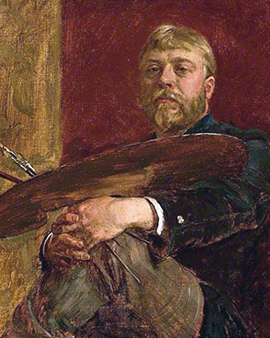Edward John Gregory, whose father and grandfather were ship engineers, was born in Southampton, England, in 1850. His grandfather, also named John Gregory, was one of the chief engineers on Sir John Franklin's last expedition to the Arctic. Unlike his paternal family, Edward John Gregory was not to become an engineer but a painter. When, at the age of 15, Gregory entered the drawing office of the Peninsular and Oriental Steam Navigation Company, a 19th century British shipping company for which his father sailed, he was fascinated by the drawings lying around. Greogory knew from this point on that he wanted to become an artist. As a result, he ended up in London, where he first went to the South Kensington Art School and later studied at the Royal Academy, albeit only for a short time. He initially earned his living as an employee at the Victoria and Albert Museum London, later he worked together with his friend and artist colleague Robert Walker Macbeth at William Luson Thomas' newly founded weekly magazine "The Graphic".
Gregory painted mainly with water and oil paints. He was known and appreciated for his artistic talent, his ingenuity and last but not least for his sophisticated, precise technique regarding his painting with watercolours. Gregory was known far beyond the British border. He won several medals and prizes at international exhibitions in Paris, Brussels and Munich. For a long time all his works even had a personal buyer: Charles J. Galloway, who lived in Manchester, was so enthusiastic about Gregory's paintings that he bought one after the other directly after their completion. After his death, the paintings were auctioned in 1905 for big money.
During Gregory's trip to Capri, Italy, he painted impressive pictures of the gardens of Augustus and Monte Solaro, the highest mountain on the island. Gregory, who held the office of President of the Royal Birmingham Society of Artists, showed great interest in this work and was a frequent and valued visitor to the school of the Academy. Together with his wife he moved to the small town of Great Marlow, west of London, where he finally died at the age of 59 and was buried by the church.
×





.jpg)
.jpg)
.jpg)
.jpg)
.jpg)
.jpg)
_-_(MeisterDrucke-958989).jpg)
_-_(MeisterDrucke-958989).jpg)
_-_(MeisterDrucke-330981).jpg)
_-_(MeisterDrucke-330981).jpg)
.jpg)
.jpg)
.jpg)
.jpg)
.jpg)
.jpg)
.jpg)
.jpg)
.jpg)
.jpg)
.jpg)
.jpg)
_-_(MeisterDrucke-548666).jpg)
_-_(MeisterDrucke-548666).jpg)
.jpg)
.jpg)
.jpg)
.jpg)
.jpg)
.jpg)
.jpg)
.jpg)
.jpg)
.jpg)
.jpg)
.jpg)
.jpg)
.jpg)
.jpg)
.jpg)
.jpg)
.jpg)
.jpg)
.jpg)
.jpg)
.jpg)
.jpg)
.jpg)
.jpg)
.jpg)
.jpg)
.jpg)
.jpg)
.jpg)
.jpg)
.jpg)
.jpg)
.jpg)
.jpg)
.jpg)
.jpg)
.jpg)
.jpg)
.jpg)
.jpg)
.jpg)
.jpg)
.jpg)
.jpg)
.jpg)
.jpg)
.jpg)
 - (MeisterDrucke-202121).jpg)
 - (MeisterDrucke-202121).jpg)
.jpg)
.jpg)
.jpg)
.jpg)
.jpg)
.jpg)
.jpg)
.jpg)
.jpg)
.jpg)
.jpg)
.jpg)
_c1880_(oil_on_canvas)_-_(MeisterDrucke-979524).jpg)
_c1880_(oil_on_canvas)_-_(MeisterDrucke-979524).jpg)
.jpg)
.jpg)
.jpg)
.jpg)
.jpg)
.jpg)
.jpg)
.jpg)
.jpg)
.jpg)
.jpg)
.jpg)
.jpg)
.jpg)
.jpg)
.jpg)
.jpg)
.jpg)
.jpg)
.jpg)
.jpg)
.jpg)
.jpg)
.jpg)
.jpg)
.jpg)
.jpg)
.jpg)
.jpg)
.jpg)
.jpg)
.jpg)
.jpg)
.jpg)
.jpg)
.jpg)
.jpg)
.jpg)
.jpg)
.jpg)
.jpg)
.jpg)






